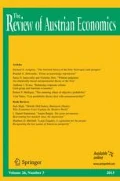Abstract
Austrian economists have contributed several important concepts to business cycle theory including: inter-temporal coordination of production and consumption, heterogeneous specificity of capital, non-neutrality of money, and the capital structure of production. Noticeably lacking, however, is a clear theory of expectations. Recent Austrian responses to rational expectations critiques—such as positing a prisoner’s dilemma, heterogeneous entrepreneurs, and adverse selection—try to fill this gap. But much work remains to be done developing an Austrian theory of expectations, one where they are endogenous to the market process and market institutions. This paper explores how people adapt their expectations to changing market phenomena based upon their perceived costs and benefits of doing so. It then applies endogenous expectations to the 2008 financial crisis.


Similar content being viewed by others
References
Akerlof, G. A., & Shiller, R. J. (2010). Animal spirits: how human psychology drives the economy, and why it matters for global capitalism (New Edition). Princeton University Press.
Bernanke, B. (2012). Federal reserve press release. December, 12, 2012.
Carilli, A. M., & Dempster, G. M. (2001). Expectations in Austrian business cycle theory: An application of the prisoner’s dilemma. The Review of Austrian Economics, 14(4), 319–330.
Cowen, T. (1998). Risk and business cycles: new and old Austrian perspectives. Routledge
Engelhardt, L. (2012). Expansionary monetary policy and decreasing entrepreneurial quality. The Quarterly Journal of Austrian Economics, 15(2), 172–194.
Evans, A. J., & Baxendale, T. (2008). Austrian business cycle theory in light of rational expectations: The role of heterogeneity, the monetary footprint, and adverse selection in monetary expansion. The Quarterly Journal of Austrian Economics, 11(2), 81–93.
Friedman, J., & Kraus, W. (2011). Engineering the financial crisis: systemic risk and the failure of regulation. Univ of Pennsylvania Press.
Frydman, R., & Phelps, E. S. (Eds.). (2013). Rethinking expectations: way forward for macroeconomics. Princeton University Press.
Garrison, R. (2001). Time and money: The macroeconomics of capital structure. Routledge
Gloy, B.A., Boehlje, M.D., Dobbins, C.L., Hurt, C. and Baker, T.G. (2011). Are economic fundamentals driving farmland values? Choices 26(2).
Hayek, F. A. (1933). Monetary theory and the trade cycle. Harcourt, Brace, & Co., Inc.
Hayek, F. A. (1935). Prices and production. Routledge & Sons
Hayek, F. A. (1945). The use of knowledge in society. The American Economic Review, 519–530.
Horwitz, S., & Boettke, P. (2009). The house that Uncle Sam built: The untold story of the great recession of 2008. L. Reed (Ed.). Foundation for Economic Freedom.
Keynes, J. M. (2006 [1936]). The general theory of employment, interest and money. Atlantic Publishers & Distributors.
Kindleberger, C. P., & Aliber, R. Z. (2011). Manias, panics and crashes: a history of financial crises. Palgrave Macmillan.
Kirzner, I. M. (1966). An essay on capital. AM Kelley
Koppl, R. (2002). Big players and the economic theory of expectations. Palgrave Macmillan
Krugman, P. R. (2000). The return of depression economics. WW Norton & Company.
Kuran, T. (1995). Private truths, public lies: The social consequences of preference falsification. Harvard University Press
Lachmann, L. M. (1943). The role of expectations in economics as a social science. Economica, 10(37), 12–23.
Lachmann, L. (1978). Capital & its structure. Institute for Humane Studies.
Lucas, R. E. (1972). Expectations and the neutrality of money. Journal of economic theory, 4(2), 103–124.
Lucas, R. E., Jr. (1975). An equilibrium model of the business cycle. The Journal of Political Economy, 1113–1144.
Minsky, H. P., & Kaufman, H. (2008). Stabilizing an unstable economy (Vol. 1). New York: McGraw-Hill.
Mises, L. V. (1949). Human Action. Liberty Fund
Mises, L. V. (2009 [1912]). Theory of money and credit. Ludwig von Mises Institute.
Mueller, P. D. (2013). The theory of interpretive frameworks: Ceteris non paribus. Quarterly Journal of Austrian Economics., 16(3), 331–352.
Muth, J. F. (1961). Rational expectations and the theory of price movements (pp. 315–335). Econometrica: Journal of the Econometric Society.
Prychitko, D. L. (2010). Competing explanations of the Minsky moment: The financial instability hypothesis in light of Austrian theory. The Review of Austrian Economics, 23(3), 199–221.
Reinhart, C. M., & Rogoff, K. S. (2009). This time is different: Eight centuries of financial folly. Princeton University Press
Salerno, J. (2012). A reformulation of Austrian business cycle theory in light of the financial crisis. Quarterly Journal of Austrian Economics, 15(1), 3–45.
Smith, V. L., Suchanek, G. L., & Williams, A. W. (1988). Bubbles, crashes, and endogenous expectations in experimental spot asset markets. Econometrica: Journal of the Econometric Society, 1119-1151.
Smith, V., Caginalp, G., & Porter, D. (2001). Financial bubbles: Excess cash, momentum, and incomplete information. The Journal of Psychology and Financial Markets, 2(2), 80–99.
Shiller, R. J. (2006). Irrational exuberance. Crown Business.
Shiller, R. J. (2011). Spotting bubbles: Is farmland next? Spring: International Economy. 2011.
Sowell, T. (2007 [1987]). A conflict of visions: Ideological origins of political struggles. Basic Books.
Surowiecki, J. (2005). The wisdom of crowds. Anchor.
Taylor, J. B. (2009). Getting off track: How government actions and interventions caused, prolonged, and worsened the financial crisis (Vol. 570). Hoover Institution Press.
Wagner, R. E. (1999). Austrian cycle theory: saving the wheat while discarding the chaff. The Review of Austrian Economics, 12(1), 65–80.
White, L. H. (2008). How did we get into this financial mess?. Cato Institute.
Woods, T. E. (2009). Meltdown: a free-market look at why the stock market collapsed, the economy tanked, and government bailouts will make things worse. Regnery Pub.
Young, A. T. (2010). A government-sponsored crisis: how Fannie and Freddie caused the recession. Collegiate Journal of Economics, 1(1), 1.
Young, A. T. (Forthcoming). Austrian Business Cycle Theory: A Modern Appraisal.
Author information
Authors and Affiliations
Corresponding author
Rights and permissions
About this article
Cite this article
Mueller, P.D. An Austrian view of expectations and business cycles. Rev Austrian Econ 27, 199–214 (2014). https://doi.org/10.1007/s11138-013-0250-8
Published:
Issue Date:
DOI: https://doi.org/10.1007/s11138-013-0250-8
Keywords
- Business cycles
- Expectations
- Financial crisis
- Information costs
- Austrian Economics
- Interpretive frameworks




